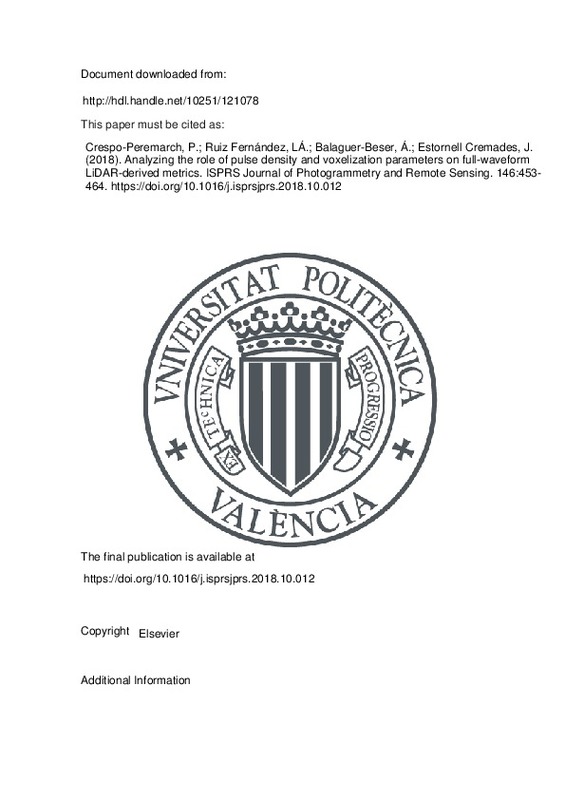JavaScript is disabled for your browser. Some features of this site may not work without it.
Buscar en RiuNet
Listar
Mi cuenta
Estadísticas
Ayuda RiuNet
Admin. UPV
Analyzing the role of pulse density and voxelization parameters on full-waveform LiDAR-derived metrics
Mostrar el registro sencillo del ítem
Ficheros en el ítem
| dc.contributor.author | Crespo-Peremarch, Pablo
|
es_ES |
| dc.contributor.author | Ruiz Fernández, Luis Ángel
|
es_ES |
| dc.contributor.author | Balaguer-Beser, Ángel
|
es_ES |
| dc.contributor.author | Estornell Cremades, Javier
|
es_ES |
| dc.date.accessioned | 2019-05-25T20:39:03Z | |
| dc.date.available | 2019-05-25T20:39:03Z | |
| dc.date.issued | 2018 | es_ES |
| dc.identifier.issn | 0924-2716 | es_ES |
| dc.identifier.uri | http://hdl.handle.net/10251/121078 | |
| dc.description.abstract | [EN] LiDAR full-waveform (LFW) pulse density is not homogeneous along study areas due to overlap between contiguous flight stripes and, to a lesser extent, variations in height, velocity and altitude of the platform. As a result, LFW-derived metrics extracted at the same spot but at different pulse densities differ, which is called ¿side-lap effect¿. Moreover, this effect is reflected in forest stand estimates, since they are predicted from LFW-derived metrics. This study was undertaken to analyze LFW-derived metric variations according to pulse density, voxel size and value assignation method in order to reduce the side-lap effect. Thirty LiDAR samples with a minimum density of 16 pulses.m¿2 were selected from the testing area and randomly reduced to 2 pulses.m¿2 with an interval of 1 pulse.m¿2, then metrics were extracted and compared for each sample and pulse density at different voxel sizes and assignation values. Results show that LFW-derived metric variations as a function of pulse density follow a negative exponential model similar to the exponential semivariogram curve, increasing sharply until they reach a certain pulse density, where they become stable. This value represents the minimum pulse density (MPD) in the study area to optimally minimize the side-lap effect. This effect can also be reduced with pulse densities lower than the MPD modifying LFW parameters (i.e. voxel size and assignation value). Results show that LFW-derived metrics are not equally influenced by pulse density, such as number of peaks (NP) and ROUGHness of the outermost canopy (ROUGH) that may be discarded for further analyses at large voxel sizes, given that they are highly influenced by pulse density. In addition, side-lap effect can be reduced by either increasing pulse density or voxel size, or modifying the assignation value. In practice, this leads to a proper estimate of forest stand variables using LFW data. | es_ES |
| dc.description.sponsorship | This research has been funded by the Spanish Ministerio de Economia y Competitividad and FEDER, in the framework of the project CGL2016-80705-R. The authors also thank the Bureau of Land Management and the Panther Creek Remote Sensing and Research Cooperative Program for the data provided. | es_ES |
| dc.language | Inglés | es_ES |
| dc.publisher | Elsevier | es_ES |
| dc.relation.ispartof | ISPRS Journal of Photogrammetry and Remote Sensing | es_ES |
| dc.rights | Reconocimiento - No comercial - Sin obra derivada (by-nc-nd) | es_ES |
| dc.subject | Airborne laser scanning | es_ES |
| dc.subject | Voxelization | es_ES |
| dc.subject | Voxel size | es_ES |
| dc.subject | Assignation value | es_ES |
| dc.subject | Side-lap effect | es_ES |
| dc.subject.classification | INGENIERIA CARTOGRAFICA, GEODESIA Y FOTOGRAMETRIA | es_ES |
| dc.subject.classification | MATEMATICA APLICADA | es_ES |
| dc.title | Analyzing the role of pulse density and voxelization parameters on full-waveform LiDAR-derived metrics | es_ES |
| dc.type | Artículo | es_ES |
| dc.identifier.doi | 10.1016/j.isprsjprs.2018.10.012 | es_ES |
| dc.relation.projectID | info:eu-repo/grantAgreement/MINECO//CGL2016-80705-R/ES/ANALISIS Y VALIDACION DE PARAMETROS DE ESTRUCTURA FORESTAL DERIVADOS DE LIDAR Y OTRAS TECNICAS EMERGENTES Y SU INCIDENCIA EN LA MODELIZACION DEL POTENCIAL COMBUSTIBLE/ | es_ES |
| dc.rights.accessRights | Abierto | es_ES |
| dc.contributor.affiliation | Universitat Politècnica de València. Departamento de Matemática Aplicada - Departament de Matemàtica Aplicada | es_ES |
| dc.contributor.affiliation | Universitat Politècnica de València. Departamento de Ingeniería Cartográfica Geodesia y Fotogrametría - Departament d'Enginyeria Cartogràfica, Geodèsia i Fotogrametria | es_ES |
| dc.description.bibliographicCitation | Crespo-Peremarch, P.; Ruiz Fernández, LÁ.; Balaguer-Beser, Á.; Estornell Cremades, J. (2018). Analyzing the role of pulse density and voxelization parameters on full-waveform LiDAR-derived metrics. ISPRS Journal of Photogrammetry and Remote Sensing. 146:453-464. https://doi.org/10.1016/j.isprsjprs.2018.10.012 | es_ES |
| dc.description.accrualMethod | S | es_ES |
| dc.relation.publisherversion | https://doi.org/10.1016/j.isprsjprs.2018.10.012 | es_ES |
| dc.description.upvformatpinicio | 453 | es_ES |
| dc.description.upvformatpfin | 464 | es_ES |
| dc.type.version | info:eu-repo/semantics/publishedVersion | es_ES |
| dc.description.volume | 146 | es_ES |
| dc.relation.pasarela | S\371743 | es_ES |
| dc.contributor.funder | Ministerio de Economía y Competitividad | es_ES |







![[Cerrado]](/themes/UPV/images/candado.png)

